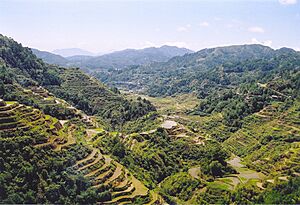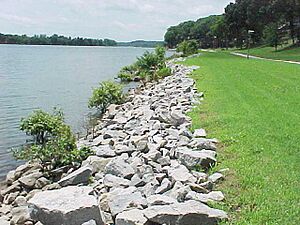Hydraulic engineering facts for kids
Hydraulic engineering is a special part of civil engineering. It deals with how liquids, especially water and sewage, move and flow. A cool thing about these systems is that they often use gravity to make the water move. This type of engineering is super important for designing things like bridges, dams, channels, canals, and levees. It's also connected to keeping our water clean and protecting the environment.
Hydraulic engineers use the rules of how fluids work to solve problems. They help collect, store, control, move, measure, and use water. Before starting a project, they need to figure out how much water is involved. They also look at how rivers carry sediment (like sand and dirt) and how water changes the land around it, causing things like erosion or new deposits. These engineers create plans for structures that work with water, such as spillways for dams, culverts under roads, canals for irrigation, and cooling systems for power plants.
Contents
Basic Ideas in Hydraulic Engineering
Some of the main ideas in hydraulic engineering include understanding how fluids behave, how water flows, and how to design systems like pipelines and open channels. It also involves studying hydrology (the science of water on Earth), how sediment moves, and how to build hydraulic machines.
How Fluids Work
A big part of hydraulic engineering is called fluid mechanics. This field studies how fluids (like water or air) act when they are still or when they are moving.
Fluids at Rest
When a fluid is still, like water in a swimming pool, it creates a force called pressure. This pressure pushes on everything around it. The deeper you go in the water, the more pressure there is. Think about how your ears pop when you dive deep! Engineers use special tools like piezometers and manometers to measure this pressure.
When something is underwater, the water pushes on all its surfaces. This push creates equal forces that balance each other out, which is called equilibrium.
Real and Ideal Fluids
Imagine a perfect, imaginary fluid that never gets sticky and can't be squished. That's an ideal fluid. But in the real world, all fluids have some stickiness, which we call viscosity. This means they don't flow perfectly smoothly.
Smooth Flow and Turbulent Flow
When water flows very smoothly, like a slow, calm river, it's called laminar flow. But when it's fast and chaotic, with lots of swirls and eddies, that's turbulent flow. Think of a fast-moving waterfall compared to a gentle stream.
Bernoulli's Principle
There's a cool idea called Bernoulli's equation (or principle). It says that for a fluid flowing smoothly, if its speed goes up, its pressure goes down, and vice versa. This principle helps engineers understand how water moves through pipes or over surfaces.
When water flows over a solid surface, like a plate, a thin layer of water right next to the surface actually sticks to it. This creates a "boundary layer" where the water's stickiness (viscosity) is important. Outside this layer, the water can be thought of as an ideal fluid.
What Hydraulic Engineers Design
Hydraulic engineers design many important structures and systems. These include:
- Dams and levees (walls to control water).
- Water supply networks for homes and fire protection.
- Systems to collect and treat sewage.
- Ways to manage storm water (rainwater runoff).
- Projects dealing with how sediment moves in rivers.
They also use ideas from fluid dynamics and fluid mechanics in other areas like mechanical engineering and even traffic engineering!
Other related jobs include studying hydrology (water on Earth) and rheology (how materials flow). They also work on things like:
- Building computer models of water flow.
- Creating maps to show where floods might happen.
- Planning how to manage floods in river areas.
- Protecting coastlines from erosion.
- Finding ways to reduce flooding.
A Look Back in Time
Ancient Times
The earliest uses of hydraulic engineering were for irrigation (watering crops). This goes back thousands of years to places like Mesopotamia (the Middle East) and ancient Egypt (Africa). People learned to control water to grow food. One of the first machines to use water was the water clock, used over 4,000 years ago.
Other old examples of moving water using gravity include the Qanat system in ancient Persia and the similar Turpan water system in ancient China. There were also irrigation canals in Peru.

In ancient China, hydraulic engineering was very advanced. Engineers built huge canals with levees and dams to guide water for irrigation. They also made locks to help ships pass through. Sunshu Ao is thought to be the first Chinese hydraulic engineer. Another important engineer, Ximen Bao, started large-scale canal irrigation during the Warring States period (481–221 BC). Even today, hydraulic engineers are highly respected in China.
In the ancient Philippines, especially on the island of Luzon, the Ifugaos people built amazing irrigation systems, dams, and the famous Banaue Rice Terraces around 1000 BC. These 2,000-year-old terraces were carved into the mountains by hand. They are fed by an old irrigation system from the rainforests above. People sometimes call them the "Eighth Wonder of the World".
Eupalinos of Megara was an ancient Greek engineer who built the Tunnel of Eupalinos in the 6th century BC. This was an amazing feat because it was dug from both ends, and the diggers had to make sure the tunnels met perfectly and had the right slope for water to flow.
The Roman Empire also had very advanced hydraulic engineering. They built many aqueducts to bring water to their cities and remove sewage. They even used water power for hydraulic mining to find gold, tin, and lead.
In the 15th century, the Ajuran Sultanate in Somalia was a powerful empire that controlled water resources using hydraulic engineering. They built many wells and cisterns (underground tanks) that are still used today.
Between the 8th and 16th centuries, during the Islamic Golden Age, there were many new developments in hydraulic engineering in the Muslim world. They brought together different water management technologies from various places. This included canals, dams, the qanat system from Persia, and water-lifting devices like the noria and shaduf from Egypt. They also used windmills from Afghanistan and developed new pumps and water supply systems.
Modern Times
Many basic ideas in hydraulic engineering haven't changed much since ancient times. Water is still mostly moved by gravity through canals and aqueducts, though pumps are now used to fill reservoirs. The need for water has grown a lot, and hydraulic engineers are crucial for making sure we have enough. For example, without engineers like William Mulholland, Los Angeles wouldn't have enough water for its large population. The same is true for many big cities around the world.
In the 17th and 18th centuries, scientists like Isaac Newton helped create the math needed to understand fluid mechanics. Later, engineers used experiments to develop practical equations for hydraulics.
Today, modern hydraulic engineers use advanced tools. They use computer-aided design (CAD) to create plans and computational fluid dynamics (CFD) to predict how water will flow. They also use GPS mapping to find the best places for systems and laser tools for construction.
See also
- Civil engineering
- Civil engineering software
- Eupalinos
- HEC-RAS
- Henri Pitot
- Hydrology
- Hydrology (agriculture)
- Hydraulic jack
- Hydraulic mining
- Hydraulic structure
- International Association for Hydro-Environment Engineering and Research
- Irrigation
- Significant modern floods
- Naval engineering
- Sunshu Ao
- Ximen Bao




